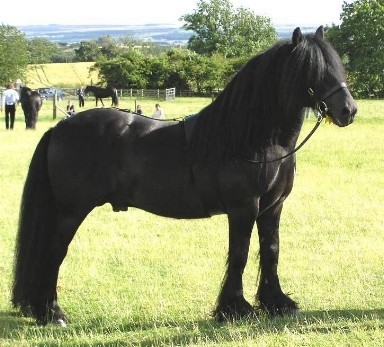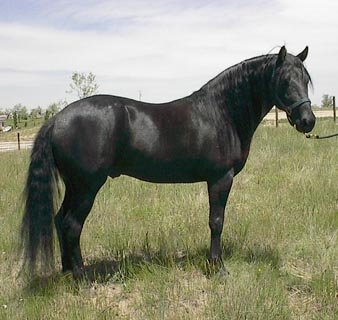black horses








In one breed, the Friesian Horse, consists exclusively of horses with black coats. These horses, of majestic stature and with long flowing manes and tails, are entirely black with no white markings on the legs or face. This ancient breed originated in Friesland (now in Holland) and are said to descend from the ancient horse Equus robustus. A considerable number of Friesian horses were imported into northern England during Roman times and influenced the development of various breeds, most notably the Fell, the Old English Black (which were used in the development of Shire Horses) and the now extinct Galloway and Fen ponies.
the genetics of the black coat
The A or agouti locus controls the distribution of black pigment in horses with at least one E+ allele: whether it occurs evenly throughout the body, as in true black horses, or only in certain parts, as in bays and browns.
The recessive allele Aa of the agouti locus has no effect on eumelanin production. Horses of genotype AaAa therefore have a base color of black. It is the Aa allele that is rare in some breeds. Breeders interested in producing black foals would ideally have horses of genotype AaAa E+E+, i.e. true-breeding blacks.
The coats of some black horses fade – or rather redden - in the sun. The genetic basis of so called fading and non-fading black isn’t currently known. However the phenomenon is well known and not confined to horses, occurring in people and cats, and probably in other animals too.
Since red (chestnut) horses are true-breeding for red it is easy to breed red foals. It is more difficult to breed black ponies and horses, since they may be of genotype E+E+ or they may be heterozygous. Breeding together heterozygous blacks may produce chestnut foals.
The red factor test is useful for people wanting to breed black horses. The red factor test is a molecular genetics test that distinguishes allele E+ from the recessive alleles (e and ea). The test is for (black) horses whose genotype at the extension locus is ambiguous, for example because they have never been used for breeding or because they have only produced one or a few (black) foals.
|
|








